We define reality through sensory experience. Some experiences challenge our notion of what is real, so we call them illusions. I could argue that illusion is reality and reality is illusion, but I won’t. Instead, I offer this: If you change the way you look at the world, the world itself changes. No one knew this better than Shigeo Fukuda.
How can you look at the world differently? How can you reveal other realities, other possibilities? How can you approach a design problem from a different angle?
I created an assignment called Paper Clever that asked these very questions. The project was inspired by the work of Shigeo Fukuda — it involved designing a system for print material surrounding an upcoming Fukuda show. The students were asked to respond to the essence of the work, not the work itself. Moreover, they had to incorporate a Gestalt principle in the making.
The results were astonishing: Gone was the flat surface, gone was the white paper, gone was the laser printout. The predictable, the practical, the probable made way for the inconceivable, unbelievable, and exceptional. It was a breakthrough assignment. It was a pivotal lesson.
The invisible is visible. The essence of Shigeo Fukuda changed the way we work, we think, we see. This visual essay is an honor to him.
Shigeo Fukuda died on January 11, 2009. Our world has suffered a great loss, indeed. But if you change the way you look at the world, the world itself changes. Perhaps the illusion here is that Shigeo Fukuda lives on.

1. Design by Kristen Morrison based on REFLECTION: “The discovery of something satisfying to the mind that was not there at the beginning of the search” — Ernest Dimnet
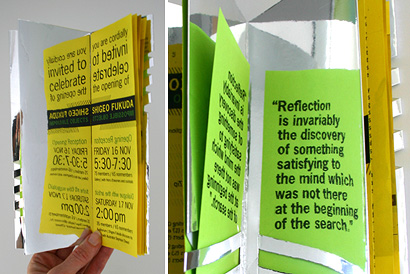
When first assigned the project to make a press packet highlighting the work of Shigeo Fukuda I was certainly a little bemused, for this name eluded me. Though, after doing some initial research, I became familiar with the Japanese designer’s wit and mystique. His work was endlessly intriguing, much of it using a very basic visual language that communicated complex ideas and illusions. This compelling, multifaceted spirit of Fukuda’s work would prove difficult to emulate or channel. Nevertheless, his work’s essence was pretty inspiring. His use of illusion, wit and humor made me think differently and transformed my approach. I stopped being confined by what was rational or practical and was free to explore contradictions and improbabilities. This lead me to consider the dichotomy of mirrors and reflections and how both are the same object while being exact opposites. Without the influence of Fukuda and his work, I fear my project would have been plagued with perpetual dullness. I have found that his influence did not cease after this one project but has endured, if only subtly, throughout all my subsequent projects where there is still a subconscious voice telling me to think in impossible ways. I would like to thank Shigeo Fukuda for all his contributions to design and this immortal influence. The name Shigeo Fukuda will never elude me again.

2. Design by Susan Baker on EMERGENCE (Gestalt): The whole is perceived rather than the sum of the parts.
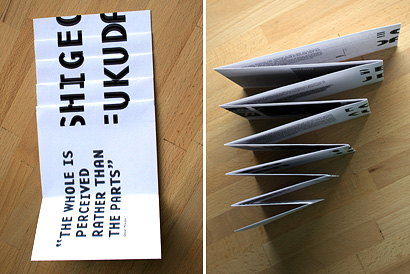

3. Design by Britt Cobb based on MULTISTABILITY (Gestalt): The tendency of ambiguous perceptual experiences to pop back and forth unstably between two or more alternative interpretations.
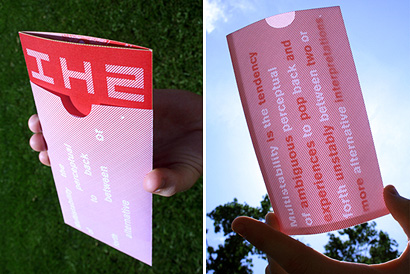
Words are printed on the front and back of an envelope. The phrase is disconnected until held up to a light source.
Red text is printed on the front and back of transparent paper. The type on back is backwards, to be read through the front, and subsequently turns the text pink.
I value Mr. Fukuda’s playfulness most. I sense that he truly loved what he did and was highly engaged by it. He exudes a genuine passion that too few of us share. I’ve learned through his work that any project, no matter how generic, has the potential to be extraordinary. It’s just a matter of investing yourself in that project. His work taught me that my work can be unexpected and sometimes unpredictable. More importantly, he has taught me to explore the possibilities of what my work can become.

4. Design by Justin Morgan based on SIMILARITY (Gestalt): Grouping similar elements into collective entities or totalities.
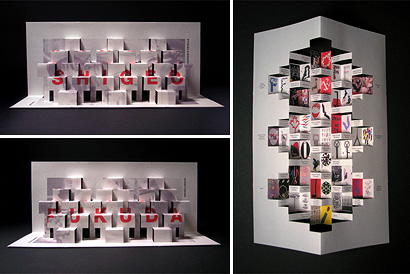
I am sorry to hear of Shigeo Fukuda’s passing but I have no doubt that his work will continue to live on and inspire many people. It is rare to learn of an artist that is a master in so many different mediums and who communicates so much joy and humor in his work. I am sure he would have taken delight in knowing that his work inspired and deeply influenced a class of young designers in North Carolina.

5. Design by Kayce Lomas based on EMERGENCE (Gestalt): The whole is perceived rather than the sum of the parts.
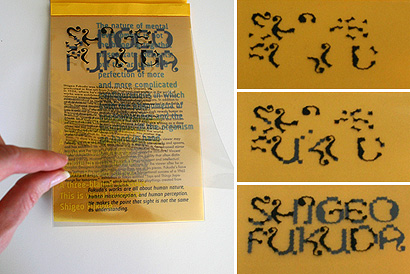
Multiple layers of transparency overlap to build text.

6. Design by Nida Abdullah based on PROXIMITY (Gestalt): Elements tend to be grouped together depending on their closeness.
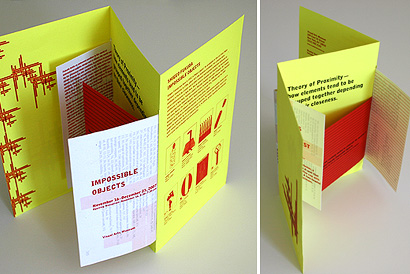
Paper woven together forces a relationship between disparate designs.
With Shigeo Fukuda work, one quick glance never suffices. Suddenly the mind is involved. How is that connected to that? Or that? In his work, Fukuda made visual connections, and would directly involve his audience. Through these types of examinations, I reached another way of seeing, of making connections; not everything is immediately visible. Perhaps it is necessary for us to probe deep within everything; one glance is never enough with anything. And anything can be connected to everything.

7. Design by Jessica Straw based on IMPOSSIBLE OBJECTS: A type of optical illusion consisting of a two-dimensional figure which is instantly interpreted by the visual system as representing a three-dimensional object although it is not possible for such an object to exist.
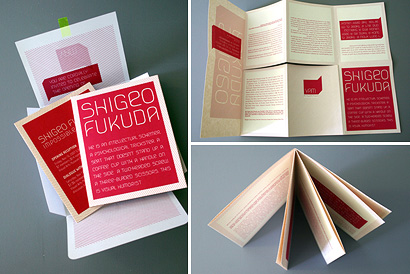

KT Meaney runs the design studio Terms & Conditions and is an adjunct professor at the College of Design, North Carolina State University.






KT,
Great work, but can you tell us a little more about the class? What level are the students and what was the time frame for producing the work?
On Feb.13.2009 at 02:49 PM